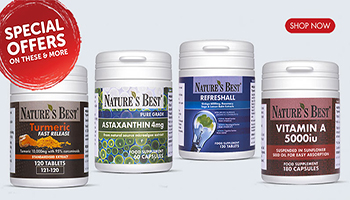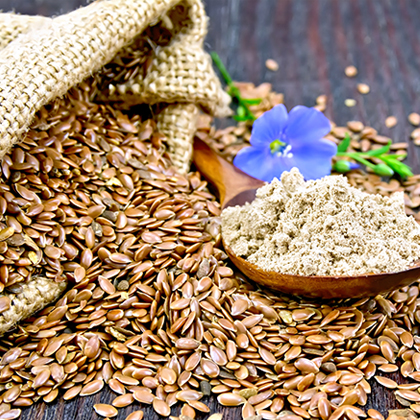
Phytoestrogens are plant-based agents that naturally imitate oestrogen in the body. Due to their unique bioactivity, these compounds have received increasing attention for their beneficial health effects.
Oestrogen falls sharply in menopause, causing a host of symptoms, such as hot flushes, mood swings, and fatigue. Phytoestrogens are thought to have a balancing effect on hormones, combating low oestrogen, and supporting your health during this time.
We can categorise phytoestrogens into three groups: isoflavones, coumestans, and lignans. Consuming more foods with oestrogenic properties may be a helpful addition or an alternative to hormone replacement therapy (HRT).
Foods to include in your diet during the menopause
Soybeans and Edamame
Processed soybeans form the basis of an assortment of plant-based food products, including tempeh, tofu, and miso. Unprocessed, raw soybeans are called edamame. Both soybeans and edamame have high levels of isoflavones, potent phytoestrogens and have demonstrated promise at moderately supporting the reduction of menopausal symptoms, like hot flushes and night sweats (1).
 Isoflavones break down into four other compounds: genistein, daidzein, biochanin A, and formononetin. These remain inactive until the gut converts them into substances that have oestrogenic properties.
Isoflavones break down into four other compounds: genistein, daidzein, biochanin A, and formononetin. These remain inactive until the gut converts them into substances that have oestrogenic properties.
In a typical Asian diet, the average woman consumes 20-50mg of isoflavones, compared to Western women, whose intake is less than 1mg a day (2), For reference, 50mg of soy isoflavones equates to 200g tofu, 100-150mg tempeh, or 3 cups of soya milk. Asian women — who mainly eat a diet of soya bean products — experience significantly fewer hot flushes than Western women, demonstrating just how potent soy properties are (3).
Learn more about using soy to manage hot flushes here.
Flaxseeds
Ground flaxseeds contain potent phytoestrogens called lignans, which may also improve menopausal symptoms. However, the results of using flaxseeds to manage menopausal symptoms have varied across different studies.
Some findings are promising, reporting that flaxseeds may reduce hot flushes and vaginal dryness (4). Others, however, have recorded no difference between the experimental and placebo groups (5).
Irrespective of this, it may still be worth supplementing with flaxseeds to evaluate if they work for you, especially since every woman requires a unique treatment plan in menopause. Moreover, aside from their proposed hormonal health role, flaxseeds are also tremendously healthy, delivering omega-3 fatty acids, antioxidants, and protein.
Take a deep dive into the science behind using flaxseeds for menopause here.
Legumes
Legumes like chickpeas, lentils, red kidney beans, and split peas are also rich sources of phytoestrogens. As with soya beans, legumes pack high isoflavones, delivering 5,530 micrograms of phytoestrogens per 100 grams (6).
Dried fruit
Dried fruits – in particular, dried prunes, apricots, and dates – are also powerful sources of phytoestrogens, providing much higher levels than their fresh varieties.7. Dried apricots are incredibly rich in phytoestrogens, supplying a generous 445.5 micrograms per 100 grams (8).
Garlic
Garlic has long been recognised for its health properties, with some animal studies suggesting it may even positively affect blood oestrogen levels (9). However, more long-term human studies are needed to corroborate these findings. Still, garlic is a tremendously healthful addition to your diet.
Grains
Rice, oats, barley, quinoa, rice bran, rye, and wheat bran are all examples of grains that supply concentrated amounts of phytoestrogens, namely lignans. Although more current data is needed to understand the effect of such grains on oestrogen levels fully, some early research highlights that wheat germ, for instance, may have a balancing effect on oestrogen levels in women (10).
Sesame seeds
Besides other essential nutrients, these tiny, fibrous seeds are also an excellent source of lignans, potent phytoestrogens. In one study on postmenopausal women, researchers reported that supplementing with 50 grams of sesame seed powder for five weeks increased oestrogen activity (11).
Cruciferous vegetables
The cruciferous vegetables, such as broccoli, cauliflower, cabbage, and Brussels sprouts, are rich in phytoestrogens (12). Broccoli and cauliflower deliver concentrated levels of secoisolariciresinol, which is a type of lignan. Whereas cabbage and Brussels sprouts contain coumestans, powerful plant compounds purported to have oestrogenic properties.
Sprouts (alfalfa and mung bean sprouts)
Sprouting seeds, like alfalfa and mung bean sprouts, are a great source of phytoestrogens. Like some cruciferous vegetables, these foods are also high in coumestans.
Foods to avoid in menopause
Spicy food
Due to the capsaicin in chillies dilating blood vessels, spicy food can trigger flushing, sweating, and other hot flush symptoms. Consider using other spices that still pack flavour without as much heat, such as turmeric, cumin, and curry powder.
Caffeine
Like spicy food, caffeine may increase the risk of hot flushes (14). Reduce your caffeine intake by swapping coffee for herbal tea.
Alcohol
Some women find that alcohol aggravates hot flushes. Taking a break or reducing your consumption may be extremely beneficial.
Processed food
Not only does processed food make weight gain more likely, but it can also increase your risk for heart disease, a health condition menopausal and postmenopausal women are already more vulnerable to developing.
Want to learn more about managing your health and wellbeing in menopause? Please visit the rest of our dedicated Menopause hub.
References:
-
Vasomotor symptom relief by soy isoflavone extract tablets in postmenopausal women: a multicenter, double-blind, randomized, placebo-controlled study. Menopause. 2000;7(6):422.
-
Hilakivi-Clarke. L, Andrade. JE, Helferich. W. 'Is Soy Consumption Good or Bad for the Breast?’ J Nutr. 2010;140(12):2326S-2334S.
-
Urmc.rochester.edu. 2020. Is Soy A Remedy For Menopausal Symptoms? Available online: https://www.urmc.rochester.edu/ob-gyn/ur-medicine-menopause-and-womens-health/menopause-blog/march-2015/is-soy-a-remedy-for-menopausal-symptoms.aspx
-
Udani J. et al., Pharmacokinetics and Bioavailability of Plant Lignan 7-Hydroxymatairesinol and Effects on Serum Enterolactone and Clinical Symptoms in Postmenopausal Women: A Single-Blinded, Parallel,Dose-Comparison Study. Journal of the American College of Nutrition. 2013;32(6):428-435.
Egelioglu CN. et al., The Effects of Flaxseed on Menopausal Symptoms and Quality of Life. Holistic Nursing Practice. 2015;29(3):151-157.
-
Shulman L. The Effects of Flaxseed Dietary Supplement on Lipid Profile, Bone Mineral Density, and Symptoms in Menopausal Women: A Randomized, Double-blind, Wheat Germ Placebo-controlled Clinical Trial. Yearbook of Obstetrics, Gynecology and Women's Health. 2006;387.
-
Dietaryfiberfood.com. 2020. High Phytoestrogens Food Sources List, Benefits, Side Effects. Available online: https://www.dietaryfiberfood.com/phytoestrogen/phytoestrogen-food-sources.php
-
Horn-Ross PL. et al., Assessing phytoestrogen exposure in epidemiologic studies: development of a database (United States). Cancer Causes Control. 2000;11(4):289-298.
-
Dietaryfiberfood.com. 2020. High Phytoestrogens Food Sources List, Benefits, Side Effects. Available online: https://www.dietaryfiberfood.com/phytoestrogen/phytoestrogen-food-sources.php
-
Mukherjee M. et al., Role of peritoneal macrophages and lymphocytes in the development of hypogonadal osteoporosis in an ovariectomized rat model: possible phytoestrogenic efficacy of oil extract of garlic to preserve skeletal health. Phytother Res. 2007;21(11):1045-1054.
Mukherjee M. et al., Role of oil extract of garlic (Allium sativum Linn.) on intestinal transference of calcium and its possible correlation with preservation of skeletal health in an ovariectomized rat model of osteoporosis. Phytother Res. 2006;20(5):408-415.
-
Rose DO. et al., Effects of diet supplementation with wheat bran on serum estrogen levels in the follicular and luteal phases of the menstrual cycle. Nutrition. 1997;13(6):535-539.
Rose DO. et al., High-fiber diet reduces serum estrogen concentrations in premenopausal women. Am J Clin Nutr. 1991;54(3):520-525.
-
Wu WH. et al., Sesame ingestion affects sex hormones, antioxidant status, and blood lipids in postmenopausal women. J Nutr. 2006;136(5):1270-1275.
-
Poluzzi E. et al., Phytoestrogens in postmenopause: the state of the art from a chemical, pharmacological and regulatory perspective. Curr Med Chem. 2014;21(4):417-36.
-
Faubion SS. et al., Caffeine and menopausal symptoms: what is the association? Menopause. 2015;22(2):155-158.
You Might Also Like
Disclaimer: The information presented by Nature's Best is for informational purposes only. It is based on scientific studies (human, animal, or in vitro), clinical experience, or traditional usage as cited in each article. The results reported may not necessarily occur in all individuals. Self-treatment is not recommended for life-threatening conditions that require medical treatment under a doctor's care. For many of the conditions discussed, treatment with prescription or over the counter medication is also available. Consult your doctor, practitioner, and/or pharmacist for any health problem and before using any supplements or before making any changes in prescribed medications.

Olivia
Olivia Salter has always been an avid health nut. After graduating from the University of Bristol, she began working for a nutritional consultancy where she discovered her passion for all things wellness-related. There, she executed much of the company’s content marketing strategy and found her niche in health writing, publishing articles in Women’s Health, Mind Body Green, Thrive and Psychologies.
View More



